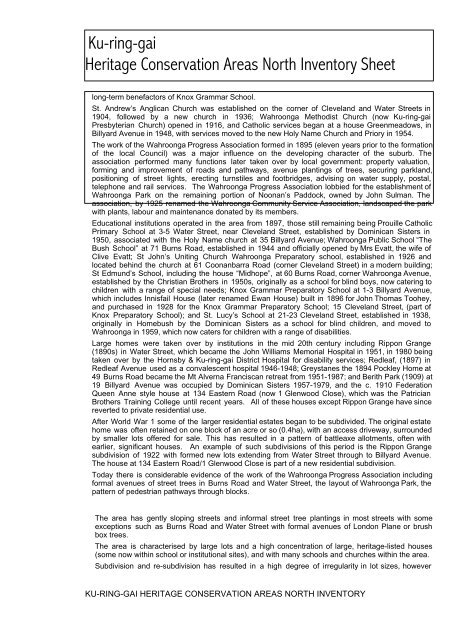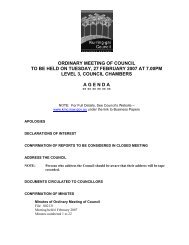Ku-ring-gai Heritage Conservation Areas North Inventory Sheet
Ku-ring-gai Heritage Conservation Areas North Inventory Sheet
Ku-ring-gai Heritage Conservation Areas North Inventory Sheet
You also want an ePaper? Increase the reach of your titles
YUMPU automatically turns print PDFs into web optimized ePapers that Google loves.
<strong>Ku</strong>-<strong>ring</strong>-<strong>gai</strong><br />
<strong>Heritage</strong> <strong>Conservation</strong> <strong>Areas</strong> <strong>North</strong> <strong>Inventory</strong> <strong>Sheet</strong><br />
long-term benefactors of Knox Grammar School.<br />
St. Andrew’s Anglican Church was established on the corner of Cleveland and Water Streets in<br />
1904, followed by a new church in 1936; Wahroonga Methodist Church (now <strong>Ku</strong>-<strong>ring</strong>-<strong>gai</strong><br />
Presbyterian Church) opened in 1916, and Catholic services began at a house Greenmeadows, in<br />
Billyard Avenue in 1948, with services moved to the new Holy Name Church and Priory in 1954.<br />
The work of the Wahroonga Progress Association formed in 1895 (eleven years prior to the formation<br />
of the local Council) was a major influence on the developing character of the suburb. The<br />
association performed many functions later taken over by local government: property valuation,<br />
forming and improvement of roads and pathways, avenue plantings of trees, secu<strong>ring</strong> parkland,<br />
positioning of street lights, erecting turnstiles and footbridges, advising on water supply, postal,<br />
telephone and rail services. The Wahroonga Progress Association lobbied for the establishment of<br />
Wahroonga Park on the remaining portion of Noonan’s Paddock, owned by John Sulman. The<br />
association, by 1925 renamed the Wahroonga Community Service Association, landscaped the park<br />
with plants, labour and maintenance donated by its members.<br />
Educational institutions operated in the area from 1897, those still remaining being Prouille Catholic<br />
Primary School at 3-5 Water Street, near Cleveland Street, established by Dominican Sisters in<br />
1950, associated with the Holy Name church at 35 Billyard Avenue; Wahroonga Public School “The<br />
Bush School” at 71 Burns Road, established in 1944 and officially opened by Mrs Evatt, the wife of<br />
Clive Evatt; St John’s Uniting Church Wahroonga Preparatory school, established in 1926 and<br />
located behind the church at 61 Coonanbarra Road (corner Cleveland Street) in a modern building;<br />
St Edmund’s School, including the house “Midhope”, at 60 Burns Road, corner Wahroonga Avenue,<br />
established by the Christian Brothers in 1950s, originally as a school for blind boys, now cate<strong>ring</strong> to<br />
children with a range of special needs; Knox Grammar Preparatory School at 1-3 Billyard Avenue,<br />
which includes Innisfail House (later renamed Ewan House) built in 1896 for John Thomas Toohey,<br />
and purchased in 1928 for the Knox Grammar Preparatory School; 15 Cleveland Street, (part of<br />
Knox Preparatory School); and St. Lucy’s School at 21-23 Cleveland Street, established in 1938,<br />
originally in Homebush by the Dominican Sisters as a school for blind children, and moved to<br />
Wahroonga in 1959, which now caters for children with a range of disabilities.<br />
Large homes were taken over by institutions in the mid 20th century including Rippon Grange<br />
(1890s) in Water Street, which became the John Williams Memorial Hospital in 1951, in 1980 being<br />
taken over by the Hornsby & <strong>Ku</strong>-<strong>ring</strong>-<strong>gai</strong> District Hospital for disability services; Redleaf, (1897) in<br />
Redleaf Avenue used as a convalescent hospital 1946-1948; Greystanes the 1894 Pockley Home at<br />
49 Burns Road became the Mt Alverna Franciscan retreat from 1951-1987; and Berith Park (1909) at<br />
19 Billyard Avenue was occupied by Dominican Sisters 1957-1979, and the c. 1910 Federation<br />
Queen Anne style house at 134 Eastern Road (now 1 Glenwood Close), which was the Patrician<br />
Brothers Training College until recent years. All of these houses except Rippon Grange have since<br />
reverted to private residential use.<br />
After World War 1 some of the larger residential estates began to be subdivided. The original estate<br />
home was often retained on one block of an acre or so (0.4ha), with an access driveway, surrounded<br />
by smaller lots offered for sale. This has resulted in a pattern of battleaxe allotments, often with<br />
earlier, significant houses. An example of such subdivisions of this period is the Rippon Grange<br />
subdivision of 1922 with formed new lots extending from Water Street through to Billyard Avenue.<br />
The house at 134 Eastern Road/1 Glenwood Close is part of a new residential subdivision.<br />
Today there is considerable evidence of the work of the Wahroonga Progress Association including<br />
formal avenues of street trees in Burns Road and Water Street, the layout of Wahroonga Park, the<br />
pattern of pedestrian pathways through blocks.<br />
The area has gently sloping streets and informal street tree plantings in most streets with some<br />
exceptions such as Burns Road and Water Street with formal avenues of London Plane or brush<br />
box trees.<br />
The area is characterised by large lots and a high concentration of large, heritage-listed houses<br />
(some now within school or institutional sites), and with many schools and churches within the area.<br />
Subdivision and re-subdivision has resulted in a high degree of irregularity in lot sizes, however<br />
KU-RING-GAI HERITAGE CONSERVATION AREAS NORTH INVENTORY

















